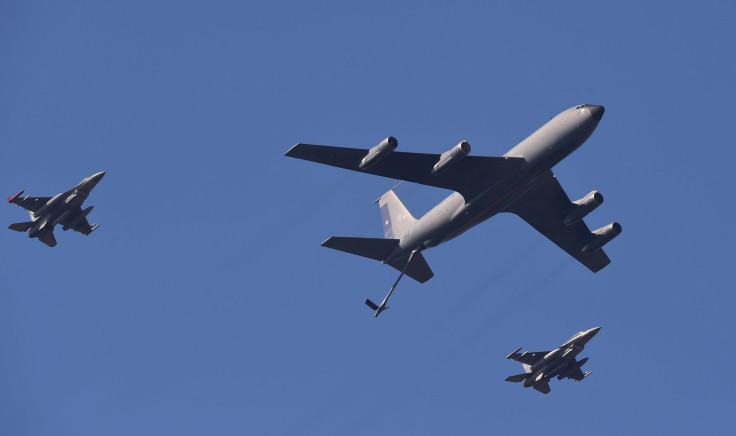US Fighter Jets Almost Collided With RAF Tanker Over North Sea

Two U.S. F-15 fighters almost collided midair with an RAF tanker off the coast of north Norfolk on Jan. 5, 2017, reports said. The crash, if it had taken place, over the North Sea could have claimed the lives of 13 crew members.
An official report released by UK Airprox Board, stated the American fighter jets came very close to colliding with the tanker which was on its way back after refueling a couple of RAF Typhoons.
One of the jets flew just about 160 feet away from the tanker at the speed of 402 mph, in what the RAF tanker pilot described as an almost “catastrophic mid-air collision."
The incident has been attributed to the negligence of the air traffic controllers at Swanwick, Hampshire, which led to confusion in the communication between the three aircraft.
The controller misunderstood the flight path of the F-15 pilots, thinking they were flying south in the geographic Wash area, while the US crews from RAF Lakenheath, Suffolk, were referring to the Wash Aerial Tactics Area (ATA) further north, BBC reported.
Read: American Airlines Flight Escorted By Air Force Fighter Jets After Disruption On Board
However, the RAF tanker was hovering over the Wash Aerial Tactics Area at the time, and after getting an all clear from the control room, proceeded on its route north.
The same air controller was convinced he had directed the jets in the right path and turned his attention to attending a “complicated” phone call, which was not part of his job.
According to the report, the call "served to further increase his workload and resulted in him focusing on that task rather than on the F-15s".
However, another air controller, who was also present at the control tower, stated the fighter jets made an abrupt turn in the direction of the tanker, which “escalated” the event, leaving her little time to handle the situation.
The tanker was at the height of 16,000 feet when its pilot learned that two fighter jets were headed toward it. One of the jets missed the tanker by so little a distance that 11 of its crew members felt the turbulence as the latter turned on its afterburner and sped away from the others.
Read: Chinese Su-30 Fighter Jets Intercept US WC-135 Constant Phoenix Plane Over East China Sea
A similar incident was reported in March 2017, when an RAF Chinook helicopter came eerily close to colliding with a drone that was flying in its path, as it attempted to land at the RAF Odiham airbase in Hampshire, England.
The location of drone was easily misread by the pilots because it appeared as a faint speck on the radar. It is only when the black-colored drone was just 130ft away that one of the co-pilots decided to act on his instincts. He grabbed the steering from his oblivious colleague and steered the helicopter out of harm’s way, the Telegraph reported.
Following the incident, the UK Airpox Board launched an investigation and found that the controller of the drone was at fault as he or she failed to"monitor its flight path in relation to other aircraft for the purpose of avoiding collisions."
According to the helicopter pilot, the drone "could have caused considerable damage that could have led to the loss of the aircraft if it had impacted either the transmissions, the associated hydraulic pipes, the rotor system or the cockpit”.
© Copyright IBTimes 2025. All rights reserved.





















